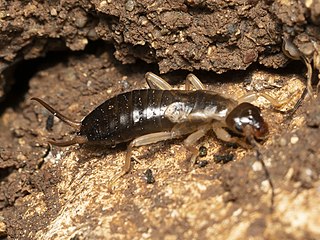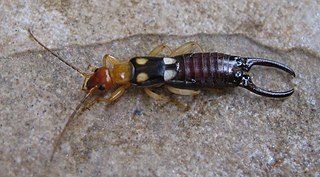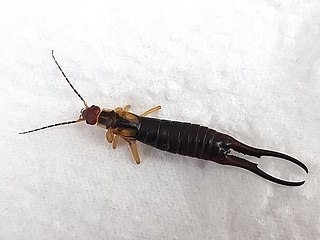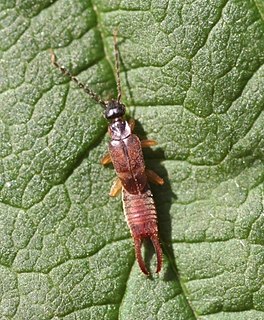
Earwigs make up the insect order Dermaptera. With about 2,000 species in 12 families, they are one of the smaller insect orders. Earwigs have characteristic cerci, a pair of forcep-like pincers on their abdomen, and membranous wings folded underneath short, rarely used forewings, hence the scientific order name, "skin wings". Some groups are tiny parasites on mammals and lack the typical pincers. Earwigs are found on all continents except Antarctica.

Forficula auricularia, the common earwig or European earwig, is an omnivorous insect in the family Forficulidae. The European earwig survives in a variety of environments and is a common household insect in North America. The name earwig comes from the appearance of the hindwings, which are unique and distinctive among insects, and resemble a human ear when unfolded; the species name of the common earwig, auricularia, is a specific reference to this feature. They are considered a household pest because of their tendency to invade crevices in homes and consume pantry foods, and may act either as a pest or as a beneficial species depending on the circumstances.

Forficulidae is a family of earwigs in the order Dermaptera. There are more than 70 genera and 490 described species in Forficulidae.
Forficula iberica is a species of earwig in the family Forficulidae.
Forficula laeviforceps is a species of earwig.

Forficula lesnei, or Lesne's earwig, is a species of earwig from Europe, particularly Britain. Compared to the common earwig, Lesne's earwig is shorter, with a body length around 8 mm (0.31 in). It can be found dwelling on the shrub Clematis vitalba.

Forficula lucasi is a species of earwig found in Africa and has been introduced to Greece.

Forficula lurida is a species of earwig in the family Forficulidae. It is mostly found in the Palaearctic realm, as well as parts of the Afrotropical realm.
Forficula mikado is a species of earwig in the family Forficulidae. They are found in the Palearctic realm, particularly in Japan.
Forficula riffensis is a species of earwig.

Forficula scudderi is a species of earwig in the family Forficulidae.

Forficula smyrnensis is a species of earwig in the family Forficulidae. It is mostly found in the Palearctic realm.

Forficula tomis is a species of earwig in the family Forficulidae.

Forficula is a genus of earwigs in the family Forficulidae. The best known species is Forficula auricularia.

Labia minor, the lesser earwig or small earwig, is a species of earwig. It is widespread globally in temperate climates, preferring warm locations such as compost heaps in parts of its range. It is 4–7 mm long, including the pincer, and chocolate brown in color.

Anemonoides apennina, the Apennine anemone or blue anemone, is a rhizomatous perennial plant in the family Ranunculaceae. It is native to southern central Europe, taking its name from the Apennine Mountains, but widely naturalised elsewhere in Europe, including the United Kingdom. It can be confused with Anemonoides nemorosa which it resembles. It grows to 20 cm. In early spring it produces single blue flowers above ferny foliage, which dies down in summer. The flowers are about 3.5 cm across, with 10-15 narrow petals. The leaves are palmate with dark green 3-lobed, toothed leaflets. The leaves are hairy underneath, which is how this plant may be distinguished from the similar Anemone blanda. It is especially valued for its ability to colonise deciduous woodlands, but it is also found in open scrub, under park trees, and near former habitation.
Megachile apennina is a species of bee in the family Megachilidae. It was described by Benoist in 1940.
Campodea apennina is a species of two-pronged bristletail in the family Campodeidae.

Lestes forficula, the rainpool spreadwing, is a species of spreadwing in the damselfly family Lestidae. It is found in the Caribbean Sea, Central America, North America, and South America.











